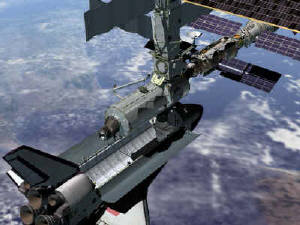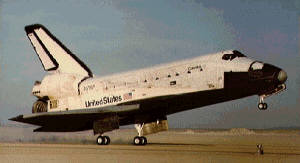 Return to
Return toAviation Answer-Man
Gateway
 Return to
Return to
Aviation Answer-Man
Gateway
 Return to
Return to.
Chapter 8
The
The Space Shuttle
Copyright 2000, 2001, 2002, 2003 by Richard Harris
All Rights Reserved

This aircraft -- a giant rocketship which turns into a 150-ton supersonic glider for its return to earth -- is the instrument which makes extensive human activity in space practical. Unlike prior manned spacecraft, this behemoth can carrry a substantial, useful load -- in both people and cargo -- and easily stay aloft for a week or two.
Designed and built by Rockwell International (now a part of Boeing) the Space Shuttle is equipped with a giant crane arm (made in Canada), and is thrust into space on giant twin Thiokol booster rockets. It is the first spacecraft to really take a "construction-equipment" approach to spacecraft: a combination "construction crane" and "flatbed truck" -- enabling astronauts to take anything into space, position it in Earth orbit, work on it, or retrieve it. The Shuttle is the first manned utility vehicle in space which can be used to come and go from earth largely at will, and to perform heavy work.
Furthermore, since this spacecraft is also an aircraft -- which can glide safely back to earth, intact -- most of it can be reused time and again. This feature slashes the cost of space travel (which used to require the building of a whole new spacecraft for every single voyage). America's handful of Space Shuttles can fly dozens of missions apiece.
 With its capacity, flexibility and efficiency, the Shuttle is THE essential vehicle for real construction developments in space -- such as the International Space Station.
With its capacity, flexibility and efficiency, the Shuttle is THE essential vehicle for real construction developments in space -- such as the International Space Station.
It also is the first truly practical vehicle for delivering, maintaining and retreiving other spacecraft -- particularly space stations (piece-by-piece) and unmanned satellites. When you consider the value of those satellites -- to defense, communications, navigation, weather forecasting, environmental studies, and geographic surveys and other practical applications -- you realize that the machine which makes them easy to move around, and maintain, is mighty significant. And that machine is the Space Shuttle.
The Space Shuttle stands alone. It has no significant competition, no competing aero-spacecraft which can do all that it does. As the only available such vehicle in the world, the U.S. Space Shuttle has helped to forge international agreements on space exploration and exploitation, as various countries of the world halt their differences with the U.S. at the edge of space, in exchange for a ride there and back. Even long-time rival Russia (whose own imitation of the Shuttle has yet to succeed) has forged strong interdependent alliances with the U.S. on the exploration of space, largely because of the value that America's Shuttle brings to their space program.
Those peaceful alliances may dissolve, as America and her challengers undertake the militarization of space. If that happens, America will be somewhat in the lead, since the Shuttle is by far the most flexible and capable platform for military operations in space -- operations which it has already performed, in some cases, during several classified military missions with purely-American crews. Whether in the right or in the wrong, the Shuttle will alter the military balance of power in space, during the critical, formative early years of space militarization -- making it arguably the most important military spacecraft since the original spacecraft of the Cold War.
 The difference between the Space Shuttle and any spacecraft that has gone before it is like the difference between the X-1 and the Concorde: one is for discovery, the other for delivery. The Space Shuttle is probably the first manned spacecraft to bring direct practical value to manned space flight, and the first to make space colonization -- at least in Earth orbit -- a plausible activity.
The difference between the Space Shuttle and any spacecraft that has gone before it is like the difference between the X-1 and the Concorde: one is for discovery, the other for delivery. The Space Shuttle is probably the first manned spacecraft to bring direct practical value to manned space flight, and the first to make space colonization -- at least in Earth orbit -- a plausible activity.
Why this aircraft stands out from its "peers."
While many other aircraft have been important, no others have had nearly so pivotal an impact on aviation or on the reach of human hands as the Space Shuttle. This aircraft is an "indispensible" aircraft -- an aircraft (aero/spacecraft, to be precise) with no significant concievable substitute available at its juncture in history.
It's this way or no way. While several other nations struggle to come up with efficient two-way rockets and shuttles and recoverable vehicles and such, the U.S. Space Shuttle -- now over two decades old -- just keeps going up and back, up and back, up and back. Millions of miles flown, and only one accident, with a single handful of deaths*. Expensive, but compared to what?
Following the latest disaster, critics have raised questions about the continued viability of the Space Shuttles, some now decades old. Critics have pointed out that many of the missions of the Shuttle, such as putting satellites in orbit, can be more cost-effectively achieved with unmanned rockets -- and the rate of Shuttle loss has now undermined the small fleet's prospective value. Other critics say a newer, more sophisticated and safer Shuttle fleet should be built.
From other segments of the spaceflight and astronomical research community, critics have complained that the costly low-Earth-orbit Shuttle has become a distraction and detraction from lunar, interplanetary and deep-space missions -- inhibiting and undermining the human reach into space, rather than extending it.
The Shuttle's role as the transport to orbital space stations has been questioned, following countless terrible problems with the first major space station, Russia's "Mir," operated jointly by America and Russia -- with considerable dependence upon the Space Shuttle. Mir has shown troubling risks (ultimately abandoned for safety reasons, it later plummeted to Earth out-of-control), dumbfounding costs, and precious little measurable value -- and has led to questioning the whole priority of establishing space stations, rather than lunar outposts, or direct interplanetary flights. Long heralded as the steppingstone to those other missions, space stations are now looking somewhat more like obstacles to them, according to some spaceflight experts. Construction of the giant International Space Station -- complicated by skyrocketing costs and strained relations between participant nations and their space agencies -- has been largely put "on hold." The Shuttle fleet, itself, has been grounded, while NASA (the U.S. National Aeronautics & Space Administration) stuggles to refine and reasses the Space Shuttle fleet and redefine its role -- along with NASA itself.
In spite of this, the Space Shuttle remains -- among air craft -- the physical pinnacle of aerodynamic flight: the first and (presently) only aircraft that reaches into the heavens, with people, and actually does productive things. As of this writing, there is no other aircraft that can do this amazing and awesome thing -- at least not on this planet!
 Return to
Return to
Eight Great Aircraft
starting page
 Return to
Return to
Aviation Answer-Man
Gateway